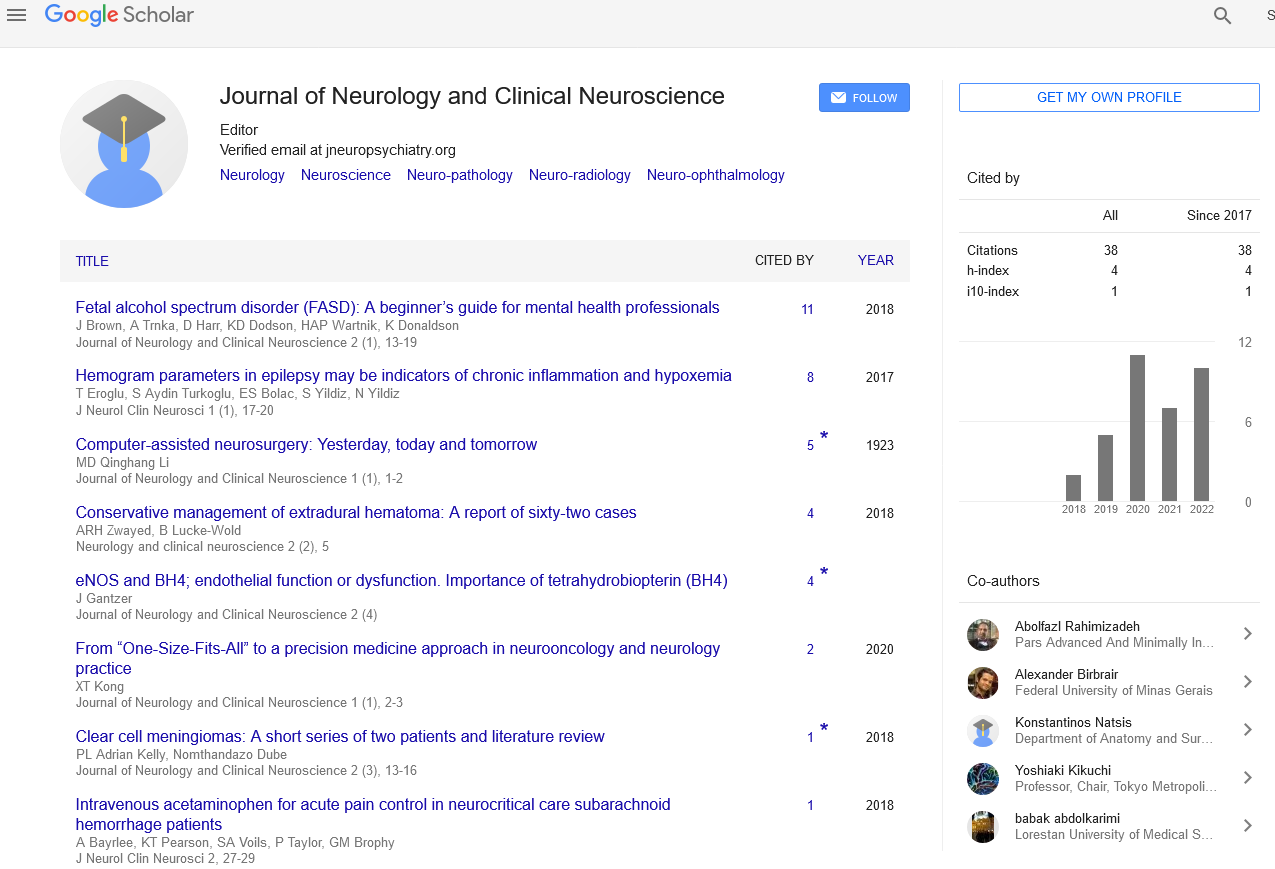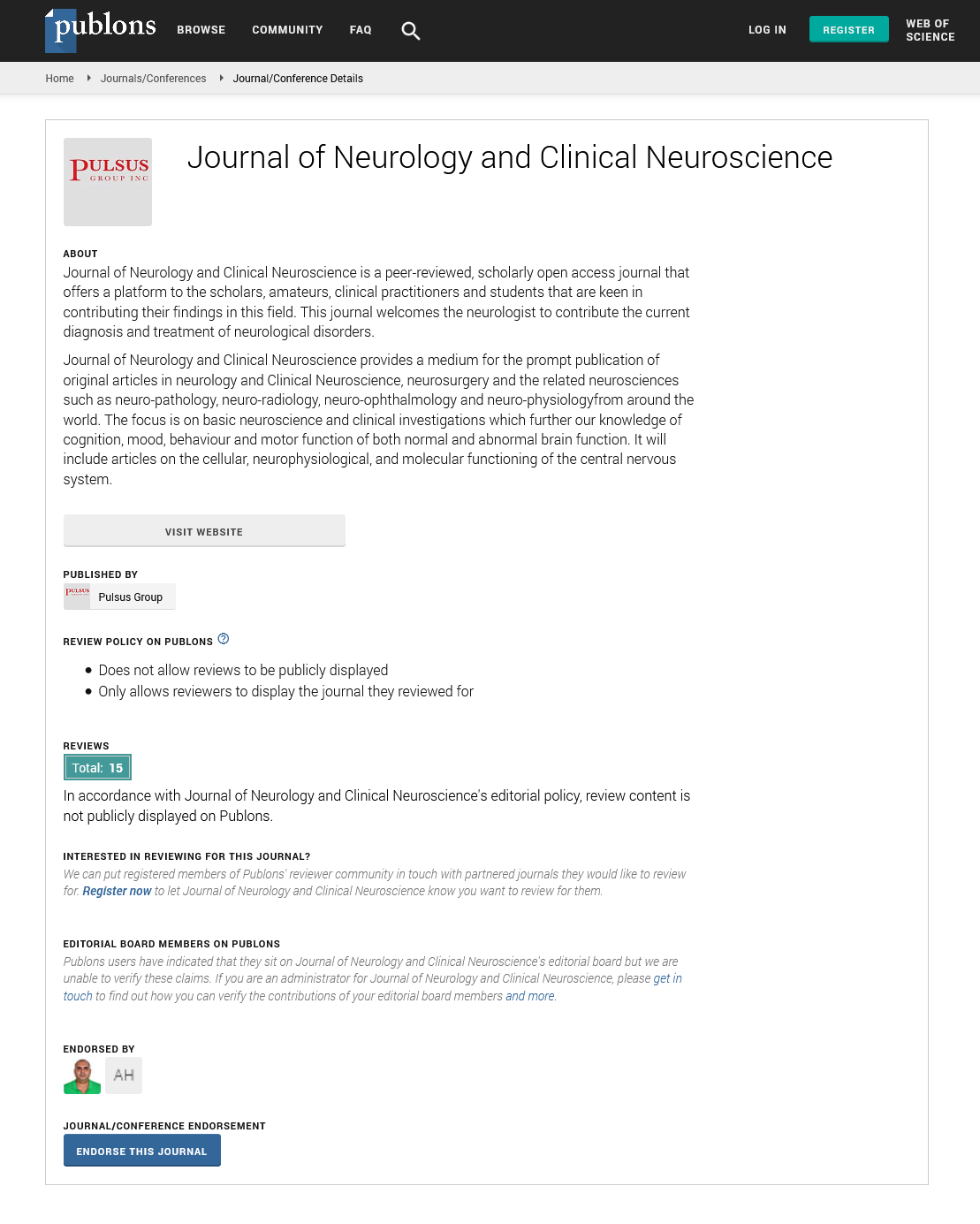Sleep abnormality in rats after cocaine withdrawal and its possible treatment
Received: 01-Sep-2017 Accepted Date: Sep 01, 2017; Published: 08-Sep-2017
Citation: Wang Y. Sleep abnormality in rats after cocaine withdrawal and its possible treatment. J Neurol Clin Neurosci. 2017;1(1):2.
This open-access article is distributed under the terms of the Creative Commons Attribution Non-Commercial License (CC BY-NC) (http://creativecommons.org/licenses/by-nc/4.0/), which permits reuse, distribution and reproduction of the article, provided that the original work is properly cited and the reuse is restricted to noncommercial purposes. For commercial reuse, contact reprints@pulsus.com
Editorial
A good sleep is necessary for maintaining our mental health and daytime activity. But for a drug user, especially for a chronic drug user, a reduced sleep quality will be expected [1,2]. After cocaine withdrawal for the chronic cocaine users, they always feel sleepy at daytime and cannot sleep at night. And these sleep problems are thought to aggravate drug use and relapse [3].
Rats’ sleep pattern consists of have Rapid-Eye-Movement (REM) sleep and Non-Rapid-Eye-Movement (NREM) sleep, which is similar to humans. Although rats don’t sleep continuously like humans, and they are nocturnal, it is still a good choice that using rats as a model in the lab research because several invasive methods, such as Adeno-Associated Virus (AAV) injection into brain and single neuron activity recorded via brain slice, are not feasible for humans. And these methods are effective to give us more knowledge about relationship between sleep and addiction. In addition, genetic modification is easy to do in mice and rats, which is also a powerful tool to investigate the genes’ functions in sleep.
For monitoring sleep in rats, Electroencephalogram (EEG) electrodes are implanted into the skull with specific coordinates targeted and Electromyogram (EMG) electrodes are sutured into the neck muscles. Combination signals of EEG and EMG can be recognized as different sleep stages such as wakefulness (W), NREM (N) and REM (R) via software automatic scoring or manually scoring. Several measurements are made to evaluate the sleep quality including total sleep time of REM and NREM sleep, numbers of transitions between different sleep stages and average episode duration, which is defined as the average length of each sleep episode.
Recent researches have shown that PD patients have more serious problems in oral health status than the general population [4,5]. Some of these disorders include increased prevalence of caries and periodontal disease, sialorrhea and drooling, xerostomia, orofacial pain, mastication disorders, bruxism and taste impairment [5].
Scientists found a reduction of total time in both REM and NREM sleep after long-term cocaine withdrawal in rats [4]. This reduction happened in both light phase and dark phase and was partly due to the reduced episode duration in both REM and NREM sleep. The transition numbers between wakefulness and NREM sleep were increased, meaning a more fragmented NREM sleep observed in cocaine-exposed animals. While the transition numbers between REM and NREM sleep were decreased, suggesting that both reduced episode duration and reduce transition numbers contributed the total REM sleep loss [4].
To improve sleep quality, different methods were introduced, including healthy diet [5], mindfulness meditation [6], music [7], exercise [8] and pharmacotherapy [9]. But none of them had clear proofs to improve sleep quality under cocaine withdrawal context. A promising approach in rats is using optogentic tools. It was reported that activation of the specific type of neurons (e.g. MCH neurons) by Adeno-associated virus (AAV) injected into brain can increase sleep time in rats [10]. But it is not maneuverable in humans. The most potential method is to redistribute sleep time during light phase and dark phase. In details, rats were sleep-restricted in the dark (active) phase, and they would be able to sleep better in the light (inactive) phase. During this manipulation, the total sleep time of two phases remained similar. This method seemed quite simple but it was proved very effective in consolidating REM sleep and reducing cocaine cravings as well [4]. The most inspiring thing is that the method is applicable to humans.
REFERENCES
- Angarita GA. Abstinence-related changes in sleep during treatment for cocaine dependence. Drug Alcohol Depend. 2014;134:343-7.
- Matuskey D, Pittman B, Forselius E, et al. A multistudy analysis of the effects of early cocaine abstinence on sleep. Drug Alcohol Depend. 2011;115:62-6.
- Puhl MD, Fang JD, Grigson PS. Acute sleep deprivation increases the rate and efficiency of cocaine self-administration, but not the perceived value of cocaine reward in rats. Pharmacol Biochem Behav. 2009; 94:262-70.
- Chen B. Sleep Regulates Incubation of Cocaine Craving. J Neurosci. 2015;35:13300-10.
- St-Onge MP, Roberts A, Shechter A, et al. Fiber and Saturated Fat Are Associated with Sleep Arousals and Slow Wave Sleep. J Clin Sleep Med. 2016;12:19-24.
- Black DS, O'Reilly GA, Olmstead R, et al. Mindfulness Meditation and Improvement in Sleep Quality and Daytime Impairment Among Older Adults With Sleep Disturbances A Randomized Clinical Trial. Jama Intern Med. 2015;175:494-501.
- Harmat L, Takacs J, Bodizs R. Music improves sleep quality in students. J Adv Nurs. 2008;62:327-35.
- Baron KG, Reid KJ, Zee PC. Exercise to Improve Sleep in Insomnia: Exploration of the Bidirectional Effects. J Clin Sleep Med. 2013;9:819-24.
- Kanji S. Pharmacological interventions to improve sleep in hospitalised adults: a systematic review. Bmj Open. 2016;6:20.
- Konadhode RR. Optogenetic stimulation of MCH neurons increases sleep. J Neurosci. 2013;33:10257-63.





